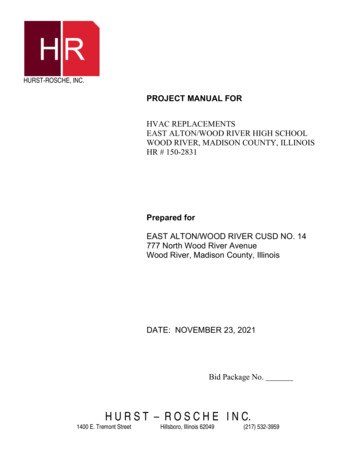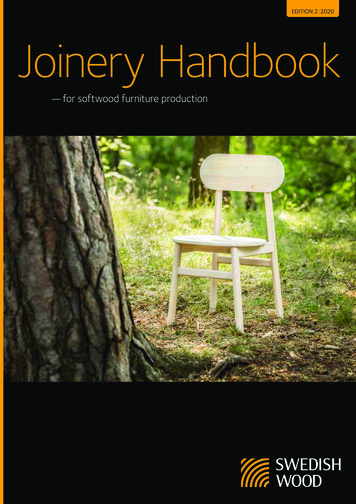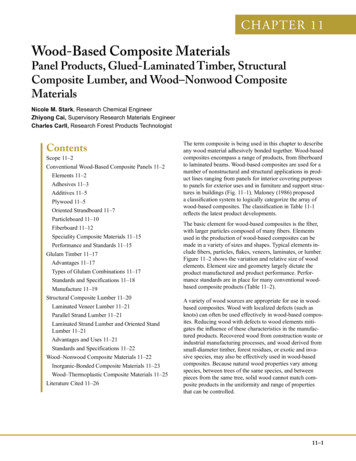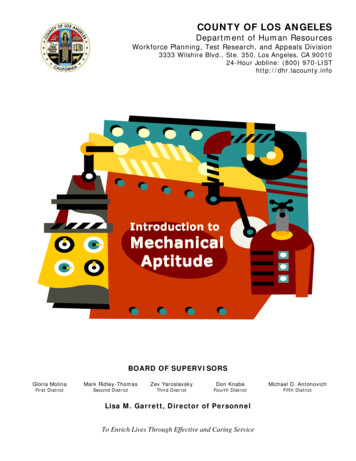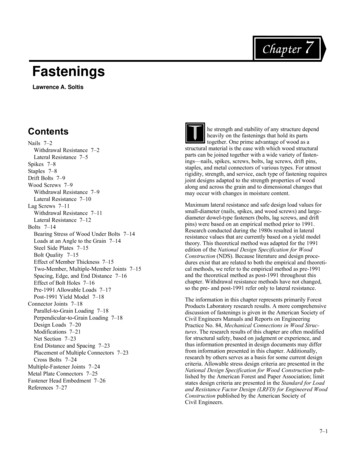
Transcription
Chapter 4Mechanical Properties of WoodDavid W. Green, Jerrold E. Winandy, and David E. KretschmannContentsOrthotropic Nature of Wood 4–1Elastic Properties 4–2Modulus of Elasticity 4–2Poisson’s Ratio 4–2Modulus of Rigidity 4–3Strength Properties 4–3Common Properties 4–3Less Common Properties 4–24Vibration Properties 4–25Speed of Sound 4–25Internal Friction 4–26Mechanical Properties of Clear Straight-Grained Wood 4–26Natural Characteristics Affecting Mechanical Properties 4–27Specific Gravity 4–27Knots 4–27Slope of Grain 4–28Annual Ring Orientation 4–30Reaction Wood 4–31Juvenile Wood 4–32Compression Failures 4–33Pitch Pockets 4–33Bird Peck 4–33Extractives 4–33Properties of Timber From Dead Trees 4–33Effects of Manufacturing and Service Environments 4–34Moisture Content 4–34Temperature 4–35Time Under Load 4–37Aging 4–41Exposure to Chemicals 4–41Chemical Treatment 4–41Nuclear Radiation 4–43Mold and Stain Fungi 4–43Decay 4–43Insect Damage 4–43References 4–44he mechanical properties presented in this chapterwere obtained from tests of small pieces of woodtermed “clear” and “straight grained” because theydid not contain characteristics such as knots, cross grain,checks, and splits. These test pieces did have anatomicalcharacteristics such as growth rings that occurred in consistent patterns within each piece. Clear wood specimens areusually considered “homogeneous” in wood mechanics.Many of the mechanical properties of wood tabulated in thischapter were derived from extensive sampling and analysisprocedures. These properties are represented as the averagemechanical properties of the species. Some properties, suchas tension parallel to the grain, and all properties for someimported species are based on a more limited number ofspecimens that were not subjected to the same sampling andanalysis procedures. The appropriateness of these latter properties to represent the average properties of a species is uncertain; nevertheless, the properties represent the best information available.Variability, or variation in properties, is common to allmaterials. Because wood is a natural material and the tree issubject to many constantly changing influences (such asmoisture, soil conditions, and growing space), wood properties vary considerably, even in clear material. This chapterprovides information, where possible, on the nature andmagnitude of variability in properties.This chapter also includes a discussion of the effect of growthfeatures, such as knots and slope of grain, on clear woodproperties. The effects of manufacturing and service environments on mechanical properties are discussed, and theireffects on clear wood and material containing growth featuresare compared. Chapter 6 discusses how these research resultshave been implemented in engineering standards.Orthotropic Nature of WoodWood may be described as an orthotropic material; that is, ithas unique and independent mechanical properties in thedirections of three mutually perpendicular axes: longitudinal,radial, and tangential. The longitudinal axis L is parallel tothe fiber (grain); the radial axis R is normal to the growthrings (perpendicular to the grain in the radial direction); and4–1
RadialTable 4–1. Elastic ratios for various species atapproximately 12% moisture contentaonertirecdiFibTangentialLongitudinalFigure 4–1. Three principal axes of wood withrespect to grain direction and growth rings.the tangential axis T is perpendicular to the grain but tangentto the growth rings. These axes are shown in Figure 4–1.Elastic PropertiesTwelve constants (nine are independent) are needed to describe the elastic behavior of wood: three moduli of elasticityE, three moduli of rigidity G, and six Poisson’s ratios µ.The moduli of elasticity and Poisson’s ratios are related byexpressions of the formµ ijEi µ jiEj,i j i, j L,R,T(4–1)General relations between stress and strain for a homogeneous orthotropic material can be found in texts on anisotropicelasticity.Modulus of ElasticityElasticity implies that deformations produced by low stressare completely recoverable after loads are removed. Whenloaded to higher stress levels, plastic deformation or failureoccurs. The three moduli of elasticity, which are denoted byEL, ER, and ET, respectively, are the elastic moduli along thelongitudinal, radial, and tangential axes of wood. Thesemoduli are usually obtained from compression tests; however, data for ER and ET are not extensive. Average values ofER and ET for samples from a few species are presented inTable 4–1 as ratios with EL; the Poisson’s ratios are shownin Table 4–2. The elastic ratios, as well as the elastic constants themselves, vary within and between species and withmoisture content and specific gravity.The modulus of elasticity determined from bending, EL,rather than from an axial test, may be the only modulus ofelasticity available for a species. Average EL values obtainedfrom bending tests are given in Tables 4–3 to 4–5. Representative coefficients of variation of EL determined with bendingtests for clear wood are reported in Table 4–6. As tabulated,EL includes an effect of shear deflection; EL from bending canbe increased by 10% to remove this effect approximately.4–2SpeciesET/ELAsh, whiteBalsaBasswoodBirch, yellowCherry, blackCottonwood, easternMahogany, AfricanMahogany, HondurasMaple, sugarMaple, redOak, redOak, whiteSweet gumWalnut, 500.1150.0560.1060.0430.092BaldcypressCedar, northern whiteCedar, western redDouglas-firFir, subalpineHemlock, westernLarch, edSlashSugarWestern whiteRedwoodSpruce, SitkaSpruce, 0870.0780.128GLR/ELGLT/EL 0120.0090.0170.0110.0100.0190.0050.0110.0030.010EL may be approximated by increasing modulus of elasticity valuesin Table 4–3 by 10%.aThis adjusted bending EL can be used to determine ER and ETbased on the ratios in Table 4–1.Poisson’s RatioWhen a member is loaded axially, the deformation perpendicular to the direction of the load is proportional to thedeformation parallel to the direction of the load. The ratio ofthe transverse to axial strain is called Poisson’s ratio. ThePoisson’s ratios are denoted by µLR, µRL, µLT, µTL, µRT, andµTR. The first letter of the subscript refers to direction ofapplied stress and the second letter to direction of lateraldeformation. For example, µLR is the Poisson’s ratio fordeformation along the radial axis caused by stress along thelongitudinal axis. Average values of Poisson’s ratios forsamples of a few species are given in Table 4–2. Values forµRL and µTL are less precisely determined than are those forthe other Poisson’s ratios. Poisson’s ratios vary within andbetween species and are affected by moisture content andspecific gravity.
Table 4–2. Poisson’s ratios for various species atapproximately 12% moisture contentSpeciesAsh, whiteAspen, quakingBalsaBasswoodBirch, yellowCherry, blackCottonwood, easternMahogany, AfricanMahogany, HondurasMaple, sugarMaple, redOak, redOak, whiteSweet gumWalnut, blackYellow-poplarBaldcypressCedar, northern whiteCedar, western redDouglas-firFir, subalpineHemlock, westernLarch, edSlashSugarWestern whiteRedwoodSpruce, SitkaSpruce, EngelmannµL Rµ TRµR Lµ TLHardwoods0.371 0.4400.6840.489 0.374—0.229 0.4880.6650.364 0.4060.9120.426 0.4510.6970.392 0.4280.6950.344 0.4200.8750.297 0.6410.6040.314 0.5330.6000.424 0.4760.7740.434 0.5090.7620.350 0.4480.5600.369 0.4280.6180.325 0.4030.6820.495 0.6320.7180.318 0.3740.3360.3820.352——————0.036 �——————————————0.040 0.0250.083 0.3600.3720.422µ LTµ 0Modulus of RigidityThe modulus of rigidity, also called shear modulus, indicates the resistance to deflection of a member caused by shearstresses. The three moduli of rigidity denoted by GLR, GLT,and GRT are the elastic constants in the LR, LT, and RTplanes, respectively. For example, GLR is the modulus ofrigidity based on shear strain in the LR plane and shearstresses in the LT and RT planes. Average values of shearmoduli for samples of a few species expressed as ratios withEL are given in Table 4–1. As with moduli of elasticity, themoduli of rigidity vary within and between species and withmoisture content and specific gravity.Strength PropertiesCommon PropertiesMechanical properties most commonly measured and represented as “strength properties” for design include modulus ofrupture in bending, maximum stress in compression parallelto grain, compressive stress perpendicular to grain, and shearstrength parallel to grain. Additional measurements are oftenmade to evaluate work to maximum load in bending, impactbending strength, tensile strength perpendicular to grain, andhardness. These properties, grouped according to the broadforest tree categories of hardwood and softwood (not correlated with hardness or softness), are given in Tables 4–3 to4–5 for many of the commercially important species. Averagecoefficients of variation for these properties from a limitedsampling of specimens are reported in Table 4–6.Modulus of rupture—Reflects the maximum loadcarrying capacity of a member in bending and is proportional to maximum moment borne by the specimen.Modulus of rupture is an accepted criterion of strength, although it is not a true stress because the formula by whichit is computed is valid only to the elastic limit.Work to maximum load in bending—Ability to absorbshock with some permanent deformation and more or lessinjury to a specimen. Work to maximum load is a measure of the combined strength and toughness of wood underbending stresses.Compressive strength parallel to grain—Maximumstress sustained by a compression parallel-to-grain specimen having a ratio of length to least dimension of lessthan 11.Compressive stress perpendicular to grain—Reportedas stress at proportional limit. There is no clearly definedultimate stress for this property.Shear strength parallel to grain—Ability to resist internal slipping of one part upon another along the grain.Values presented are average strength in radial and tangential shear planes.Impact bending—In the impact bending test, a hammerof given weight is dropped upon a beam from successivelyincreased heights until rupture occurs or the beam deflects152 mm (6 in.) or more. The height of the maximumdrop, or the drop that causes failure, is a comparative valuethat represents the ability of wood to absorb shocks thatcause stresses beyond the proportional limit.Tensile strength perpendicular to grain—Resistance ofwood to forces acting across the grain that tend to split amember. Values presented are the average of radial andtangential observations.Hardness—Generally defined as resistance to indentationusing a modified Janka hardness test, measured by the loadrequired to embed a 11.28-mm (0.444-in.) ball to one-halfits diameter. Values presented are the average of radial andtangential penetrations.Tensile strength parallel to grain—Maximum tensilestress sustained in direction parallel to grain. Relativelyfew data are available on the tensile strength of variousspecies of clear wood parallel to grain. Table 4–7 lists average tensile strength values for a limited number ofspecimens of a few species. In the absence of sufficient tension test data, modulus of rupture values are sometimessubstituted for tensile strength of small, clear, straightgrained pieces of wood. The modulus of rupture is considered to be a low or conservative estimate of tensile strengthfor clear specimens (this is not true for lumber).4–3
Table 4–3a. Strength properties of some commercially important woods grown in the United States (metric)aStatic bendingCommon speciesnamesAlder, gBasswood, AmericanBeech, AmericanBirchPaperSweetYellowButternutCherry, blackChestnut, AmericanCottonwoodBalsam 4–4Modulus ModulusofofMoisture Specific rupture elasticity ccontent gravityb (kPa)(MPa)45,00068,000ComWork toCom- pression Shear Tensionmaxipression perpen- parallel perpen- Sidemum Impact parallel diculartodicular hardload bending to grain to grain grain to grain ness(kJ/m3) (mm)(kPa)(kPa) (kPa) 6,0000.60 000.5659,0000.64 en12%0.4844,0000.5585,0000.6065,0000.65 117,0000.5557,0000.62 00 2,700 2,0007,400 2,900 ,1002,6006,8003,7008,9007,000 56,30016,70036,20024,40049,00017,00036,7001,900 5,800 2,600 2,5004,100 8,300 — 4,0003,200 8,500 3,000 4,3007,400 15,400 6,600 6,5003,000 7,700 3,000 3,6006,700 13,000 6,300 5,6001,500 5,200 3,000 1,7003,200 8,100 3,000 2,2002,500 7,800 3,900 2,9004,800 11,700 3,900 4,2002,100 5,500 3,000 1,9004,300 7,400 3,200 .4650,0000.5081,0000.5766,0000.63 ,7004,3004,0002,8003,700——2,9003,8003,1003,900
Table 4–3a. Strength properties of some commercially important woods grown in the United States (metric)a—con.Common speciesnamesHickory, pecanBitternutNutmegPecanWaterHickory, ust, blackMagnoliaCucumber treeSouthernMapleBigleafBlackRedSilverSugarOak, redBlackCherrybarkLaurelNorthern redPinScarletSouthern redWaterStatic bendingComWork toCom- pressionModulus Modulus maxipression perpenofofmum Impact parallel dicularMoisture Specific rupture elasticity c load bending to grain to graincontent gravityb (kPa)(MPa)(kJ/m3) en- Sidedicular hardto grain —————10,200 4,700 1,2201,0208108107406401,02099022,300 3,10041,000 5,20022,500 4,10046,100 7,00022,600 2,80045,100 6,90017,200 2,60036,000 5,10027,700 4,40054,000 4–5
Table 4–3a. Strength properties of some commercially important woods grown in the United States (metric)a—con.Common speciesnamesOak, red—con.WillowOak, whiteBurChestnutLiveOvercupPostSwamp chestnutSwamp whiteWhiteSassafrasSweetgumSycamore, AmericanTanoakTupeloBlackWaterWalnut, blackWillow, blackYellow-poplarBaldcypressCedarAtlantic whiteEastern redcedarIncenseNorthern white4–6Static bendingComWork toCom- pressionModulus Modulus maxipression perpenofofmum Impact parallel dicularMoisture Specific rupture elasticity c load bending to grain to graincontent gravityb (kPa)(MPa)(kJ/m3) (mm)(kPa)(kPa)Shear Tensionparallel perpentodiculargrain to grain(kPa) (kPa)Sidehardness(N)Green12%0.5651,0000.69 5755,0000.6692,0000.8082,0000.88 059,0000.6796,0000.6468,0000.72 122,0000.6057,0000.68 0——22,700 4,70041,800 8,30024,300 3,70047,100 5,80037,400 14,10061,400 19,60023,200 3,70042,700 5,60024,000 5,90045,300 9,90024,400 3,90050,100 7,70030,100 5,20059,300 8,20024,500 4,60051,300 7,40018,800 2,60032,800 5,90021,000 2,60043,600 4,30020,100 2,50037,100 00.55 061064061024,70043,9002,8005,0005,6006,9002,100 1,7001,900 00
Table 4–3a. Strength properties of some commercially important woods grown in the United States (metric)a—con.Common speciesnamesCedar—con.Port-OrfordWestern redcedarYellowDouglas-firdCoastInterior WestInterior NorthInterior SouthFirBalsamCalifornia redGrandNoblePacific arch, westernPineEastern whiteJackLoblollyLodgepoleLongleafPitchStatic bendingComWork toCom- pression Shear TensionModulus Modulus maxipression perpen- parallel perpen- Sideofofmum Impact parallel diculartodicular hardMoisture Specific rupture elasticity c load bending to grain to grain grain to grain nesscontent gravityb (kPa)(MPa)(kJ/m3) (mm)(kPa)(kPa)(kPa) 59,0000.59 ��—4–7
Table 4–3a. Strength properties of some commercially important woods grown in the United States (metric)a—con.Common afSlashSpruceSugarVirginiaWestern mannRedSitkaWhiteTamarackStatic bendingComWork toCom- pression Shear TensionModulus Modulus maxipression perpen- parallel perpen- Sideofofmum Impact parallel diculartodicular hardMoisture Specific rupture elasticity c load bending to grain to grain grain to grain nesscontent gravityb (kPa)(MPa)(kJ/m3) (mm)(kPa)(kPa)(kPa) 59 ,30016,80034,7003,000 6,500——6,300 9,500——1,900 4,800 2,100 1,4004,000 7,800 2,900 2,0001,800 4,800 2,100 1,5004,100 8,400 3,200 2,5003,100 7,900——5,800———2,400 6,300 2,200 2,0005,700 9,600 3,200 3,1003,700 6,600——7,000 11,600——1,900 6,200—2,0005,000 10,300—2,9001,400 5,000 1,900 1,2003,400 7,800 2,400 1,7002,700 6,100 2,800 2,4006,300 9,300 2,600 3,3001,300 4,700 1,800 1,2003,200 001,7002,600Results of tests on small clear specimens in the green and air-dried conditions, converted to metric units directly fromTable 4–3b. Definition of properties: impact bending is height of drop that causes complete failure, using0.71-kg (50-lb) hammer; compression parallel to grain is also called maximum crushing strength; compressionperpendicular to grain is fiber stress at proportional limit; shear is maximum shearing strength; tension is maximumtensile strength; and side hardness is hardness measured when load is perpendicular to grain.bSpecific gravity is based on weight when ovendry and volume when green or at 12% moisture content.cModulus of elasticity measured from a simply supported, center-loaded beam, on a span depth ratio of 14/1. To correctfor shear deflection, the modulus can be increased by 10%.dCoast Douglas-fir is defined as Douglas-fir growing in Oregon and Washington State west of the Cascade Mountainssummit. Interior West includes California and all counties in Oregon and Washington east of, but adjacent to, theCascade summit; Interior North, the remainder of Oregon and Washington plus Idaho, Montana, and Wyoming; andInterior South, Utah, Colorado, Arizona, and New Mexico.a4–8
Table 4–3b. Strength properties of some commercially important woods grown in the United States (inch–pound)aStatic bendingCommon speciesnamesAlder, gBasswood, AmericanBeech, AmericanBirchPaperSweetYellowButternutCherry, blackChestnut, AmericanCottonwoodBalsam, ComCom- pressionModulusModulusWork topression perpenofofmaximum Impact parallel dicularMoisture Specific rupture elasticity cbending to grain to grainloadcontent gravityb (lbf/in2) ( 106 lbf/in2) (in-lbf/in3) (in.) (lbf/in2) n- Sidedicular hardto grain ness(lbf/in2) 501803701703705401,010730 —1
usually considered “homogeneous” in wood mechanics. Many of the mechanical properties of wood tabulated in this chapter were derived from extensive sampling and analysis procedures. These properties are represented as the average mechanical properties of the species. Some properties, such

